Top 10 Open Source AI Chatbot to use!

Top 10 Open Source AI Chatbot to use!
AI chatbots are transforming how businesses and individuals manage customer interactions. Open source chatbots stand out because they offer code access, customization, and lower costs. They can reduce support tickets by 35%, speed up resolution times by 60%, and save businesses an average of $25,000 annually.
Here are the top 10 open source AI chatbots you can use today:
- OpenAssistantGPT: No-code chatbot creation with GPT models, enterprise-grade security, and lead generation tools.
- Rasa: Python-based framework for building context-aware assistants with NLU and dialogue management.
- Botpress: Developer-friendly platform with a visual flow editor and multi-language support.
- Mycroft: Voice and text assistant focusing on privacy and local data processing.
- NLTK: Python library with NLP tools for building rule-based bots.
- ChatterBot: Python chatbot that learns from conversations and supports custom training.
- Leon: Modular personal assistant with offline operation and cross-platform compatibility.
- Hugging Face Transformers: Pre-trained models for advanced NLP tasks, including conversational AI.
- Wit.ai: Natural language processing platform for building conversational applications.
- Airy: Framework for large-scale customer service automation with real-time messaging.
Quick Comparison
| Chatbot | Key Features | Best For | Technical Requirements |
|---|---|---|---|
| OpenAssistantGPT | GPT models, web crawling, lead gen | Businesses needing no-code tools | None (cloud-based) |
| Rasa | NLU, dialogue management | Complex conversations | Python 3.7+, 4GB RAM |
| Botpress | Visual flow editor, multi-language | Developers | Node.js 12+, 2GB RAM |
| Mycroft | Privacy, local processing | Voice/text interactions | Linux, 1GB RAM |
| NLTK | NLP tools for text processing | Rule-based bots | Python 3+ |
| ChatterBot | Learns from conversations | Custom training | Python 3+ |
| Leon | Modular, offline operation | Personal assistants | Node.js 16+, Python 3.8+ |
| Hugging Face | Pre-trained NLP models | Advanced conversational AI | Python 3.8+, GPU optional |
| Wit.ai | NLP platform | Conversational applications | None (cloud-based) |
| Airy | Real-time messaging, plugins | Large-scale automation | Node.js, Docker |
Choose the chatbot that fits your needs based on scalability, technical setup, and cost.
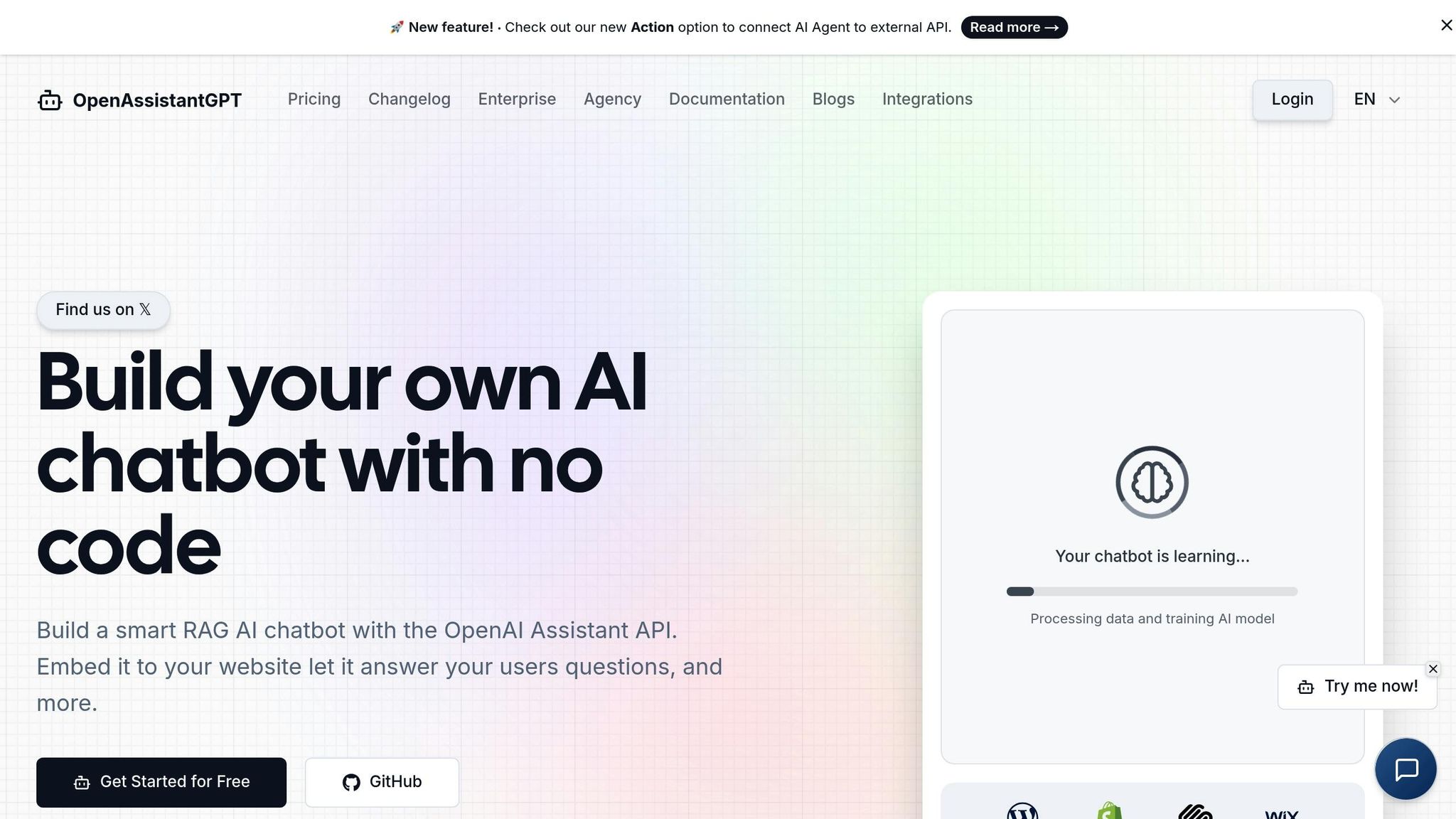
OpenAssistantGPT is a platform that lets you create AI-driven chatbots without any coding, leveraging OpenAI's Assistant API. With a user base exceeding 4,000, it helps businesses streamline customer interactions and automate support tasks.
Key Features
- Web Crawling: Automatically gathers and processes content from your website to train the chatbot.
- File Analysis: Supports multiple file types, including CSV, XML, and images.
- API Integration: Facilitates dynamic interactions through AI Agent Actions.
- Lead Generation: Includes tools to collect user contact details.
- Authentication: Offers enterprise-grade SAML/SSO security for private chatbots.
Reported Benefits
Businesses using OpenAssistantGPT have seen measurable results:
| Metric | Improvement |
|---|---|
| Support Ticket Reduction | 35% |
| Resolution Time | 60% faster |
| Annual Cost Savings | $25,000 |
Pricing Plans
- Free Plan ($0): Includes 500 monthly messages, great for testing.
- Basic Plan ($18/month): Supports up to 9 chatbots, suitable for small businesses.
- Pro Plan ($54/month): Designed for growing companies, allowing 27 chatbots.
- Enterprise Plan: Custom pricing for unlimited features and capabilities.
OpenAssistantGPT uses GPT-4, GPT-3.5, and GPT-4o models to deliver accurate, high-quality responses. Its open-source framework allows for extensive customization while maintaining enterprise-level security.
The platform also offers an open-source SDK for easy deployment via NextJS in Vercel. This makes it an appealing option for organizations that want both flexibility and control over their chatbot implementations.
2. Rasa
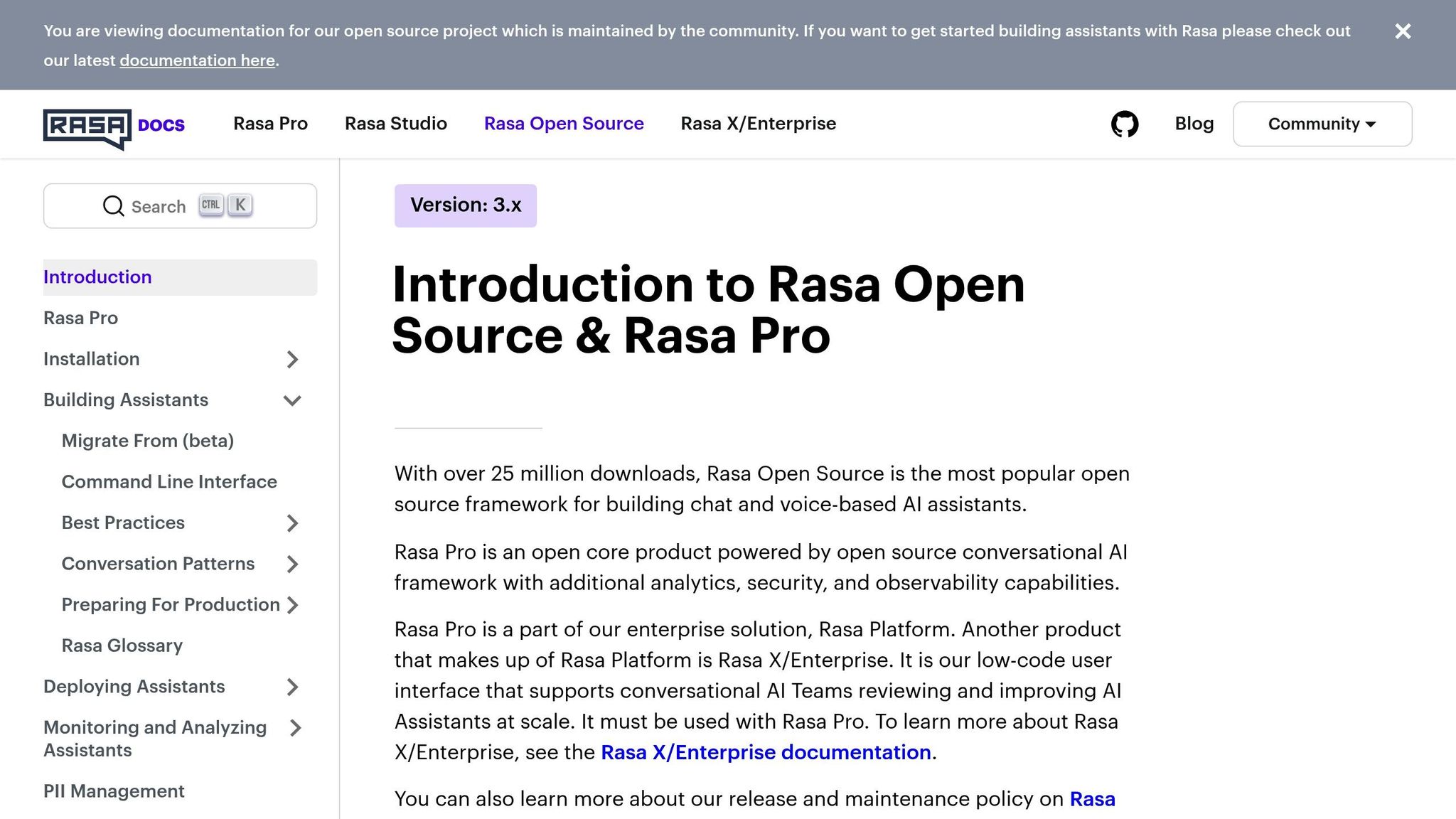
Rasa is an open-source framework designed for building AI assistants that can handle complex conversations. Built with Python, it enables the creation of advanced, context-aware chatbots. Here's a closer look at what Rasa offers and how it can be deployed.
Core Features
Rasa's framework is built around two key components:
-
NLU (Natural Language Understanding):
- Classifies user intents
- Extracts entities
- Selects appropriate responses
- Supports custom pipelines
-
Core Dialogue Management:
- Tracks conversation context
- Generates responses
- Manages multi-turn conversations
Deployment Options
Rasa provides several deployment methods to suit different needs:
| Deployment Type | Key Features | Suitable For |
|---|---|---|
| On-premises | Full control over data, Custom integrations | Large enterprises |
| Cloud-native | Scalable, Managed services | Expanding businesses |
| Hybrid | Mix of flexibility and security | Medium-sized companies |
Technical Requirements
To run Rasa, you'll need:
- Python 3.7 or higher
- At least 4GB RAM
- 2 CPU cores
- 10GB of storage
How to Get Started
Here’s a quick guide to implementing Rasa:
-
Prepare Training Data
- Create examples for intents
- Annotate entities
- Provide dialogue samples
-
Configure the Model
- Choose a pipeline
- Set up policies
- Define custom actions
-
Test and Deploy
- Run interactive tests
- Validate integrations
- Monitor performance
Rasa supports multiple languages, integrates with popular messaging platforms, and offers a modular setup for custom extensions. It's a solid choice for applications like customer service and process automation.
3. Botpress
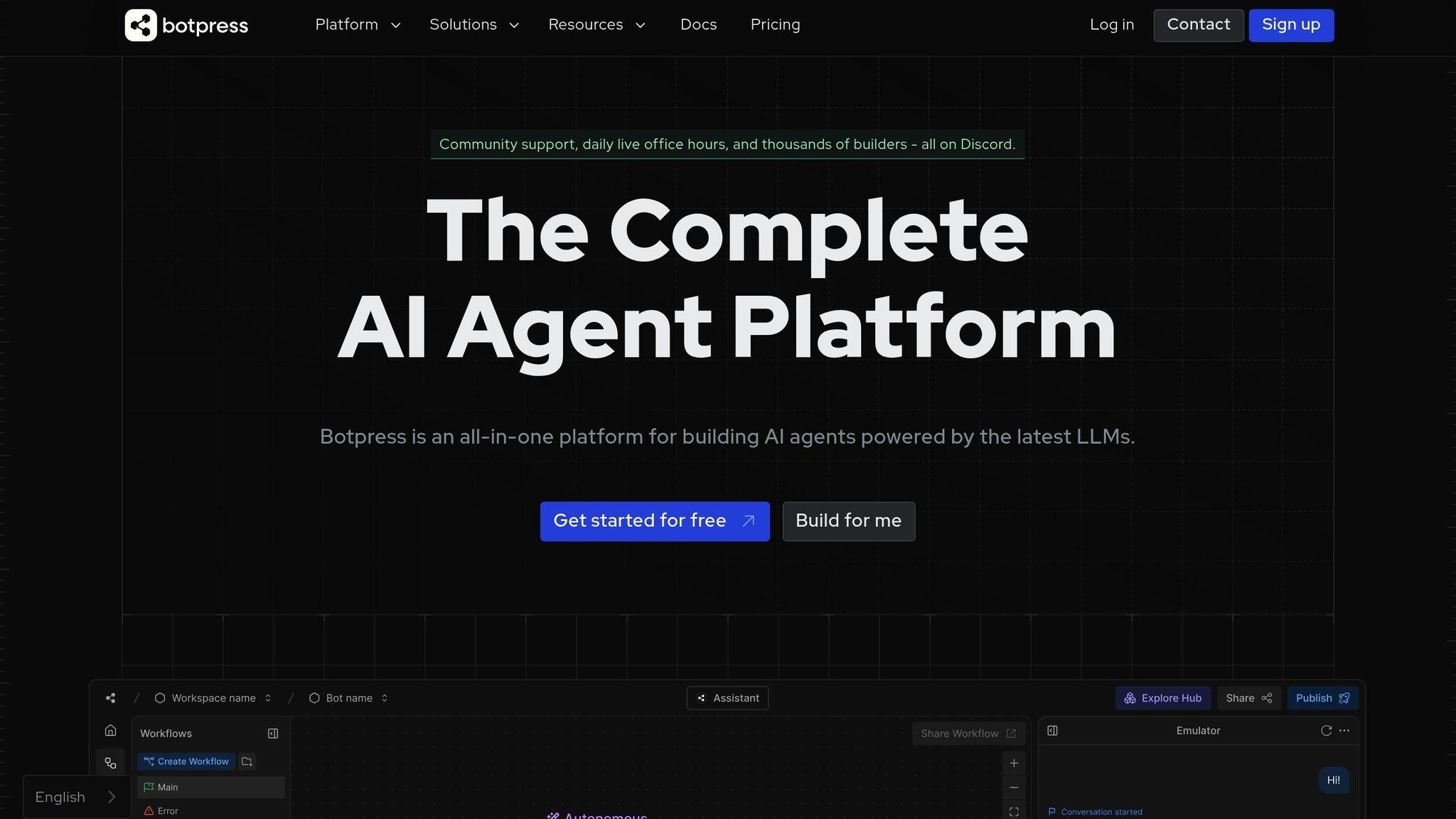
Botpress is an open-source chatbot platform designed for developers. It allows users to build advanced AI chatbots using a visual flow editor.
Key Features
Botpress stands out with several developer-focused tools:
-
Visual Flow Builder
- Drag-and-drop interface for easy design
- Real-time testing to refine conversations
- Clear visual mapping of chatbot flows
-
Natural Language Understanding
- Recognizes user intents automatically
- Extracts key entities from conversations
- Supports over 50 languages for global reach
-
Development Tools
- Create custom actions with JavaScript
- Seamlessly integrate APIs
- Includes webhook support for flexibility
System Requirements
To run Botpress smoothly, ensure your setup meets these specifications:
| Component | Minimum Requirement |
|---|---|
| Memory | 2GB RAM |
| Storage | 1GB free space |
| CPU | 2 cores |
| Node.js | Version 12+ |
Development Tools and Insights
Botpress offers a range of tools to streamline development:
-
Code Editor
Includes an IDE-like environment with syntax highlighting and real-time debugging. -
Analytics Dashboard
Tracks conversation flows, user interactions, and performance metrics. -
Security Features
Implements role-based access, API key management, and data encryption.
These features make it easier to build, test, and secure chatbot applications.
Deployment Options
Botpress supports flexible deployment methods to fit different needs:
| Deployment Type | Best For | Key Benefits |
|---|---|---|
| Self-hosted | Enterprise | Full control |
| Docker | Development | Quick and simple setup |
| Cloud | Small teams | Managed services |
With a modular design, Botpress is adaptable for both basic chatbots and complex conversational systems. Developers also benefit from its active community and detailed documentation, which provide guidance and support for projects of any scale.
4. Mycroft
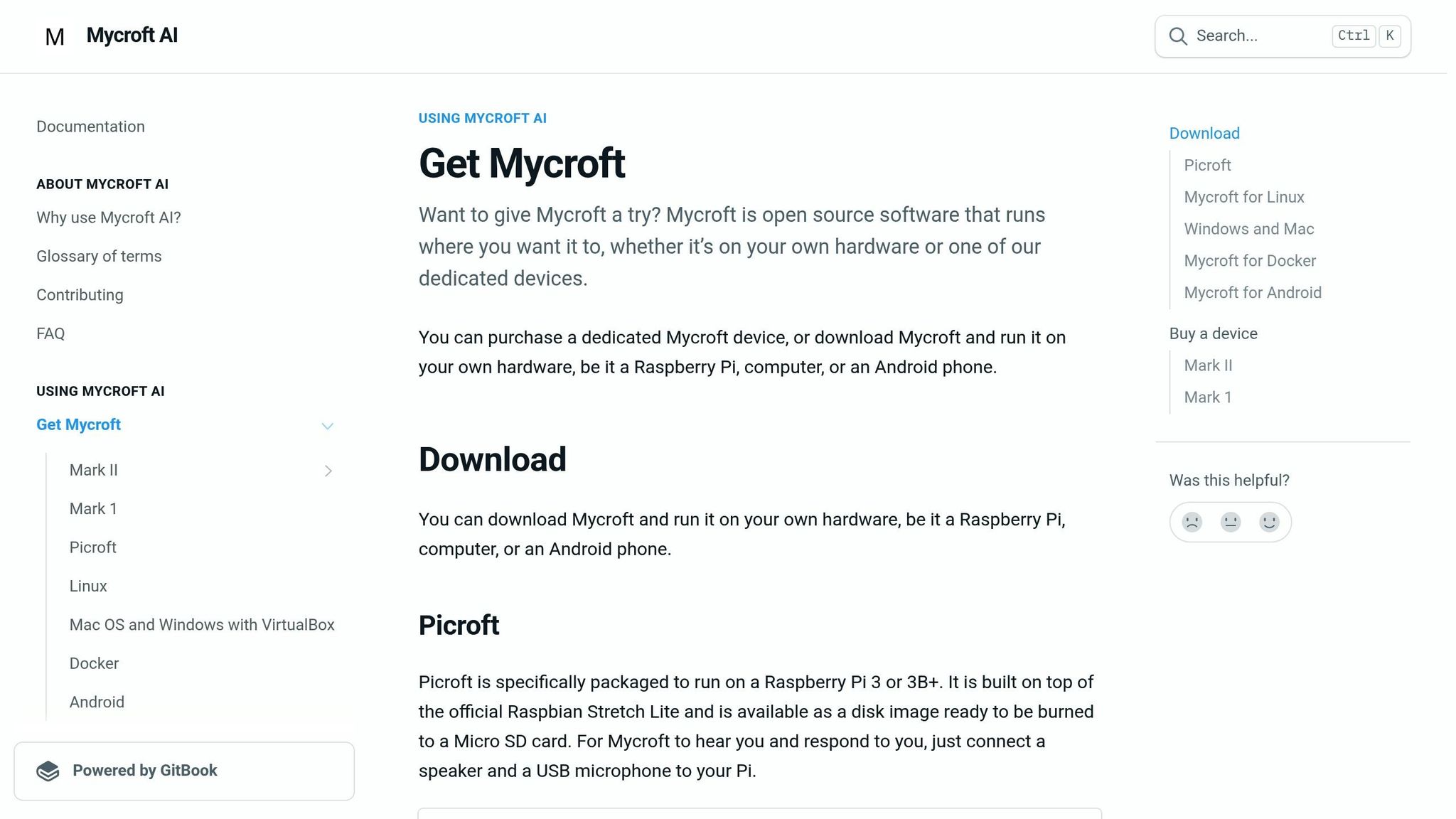
Mycroft is an open-source voice assistant designed with privacy in mind, supporting both voice and text interactions.
Core Features
Here’s what Mycroft offers:
- Local Data Processing: Your data stays private, with the option to run without relying on the cloud.
-
Multi-Platform Compatibility:
- Works on Linux
- Optimized for Raspberry Pi
- Can be deployed using Docker containers
-
Skill Development Framework:
- Build skills using Python
- Access a community marketplace for skills
- Flexible wake word options
Technical Requirements
To run Mycroft smoothly, these system specifications are recommended:
| Component | Recommended Specs |
|---|---|
| CPU | 1.5 GHz dual-core |
| RAM | At least 1 GB |
| Storage | 10 GB of free space |
| OS | Linux/Unix-based system |
| Network | Stable internet connection |
Voice Integration Options
Mycroft offers various speech-to-text (STT) integration choices, depending on your needs:
| Integration Type | Best For | Complexity |
|---|---|---|
| Local STT | Privacy concerns | Medium |
| Cloud STT | High accuracy | Low |
| Hybrid Mode | Balanced approach | High |
Development Tools
Mycroft provides several tools to simplify creating and customizing its capabilities:
- Mycroft Skills Kit (MSK): A command-line tool for building, testing, and packaging skills.
- Adapt Intent Parser: Helps with natural language understanding and intent matching.
- Precise Wake Word Engine: Use machine learning to create custom wake words.
These tools align with Mycroft’s focus on privacy and cross-platform functionality.
Implementation Example
Here’s a simple way to develop a skill for handling voice and text interactions:
from mycroft import MycroftSkill, intent_handler
class ChatbotSkill(MycroftSkill):
@intent_handler('chat.intent')
def handle_chat(self, message):
self.speak_dialog('response')
This example demonstrates how developers can create conversational interfaces that integrate smoothly with Mycroft while prioritizing user privacy.
5. NLTK
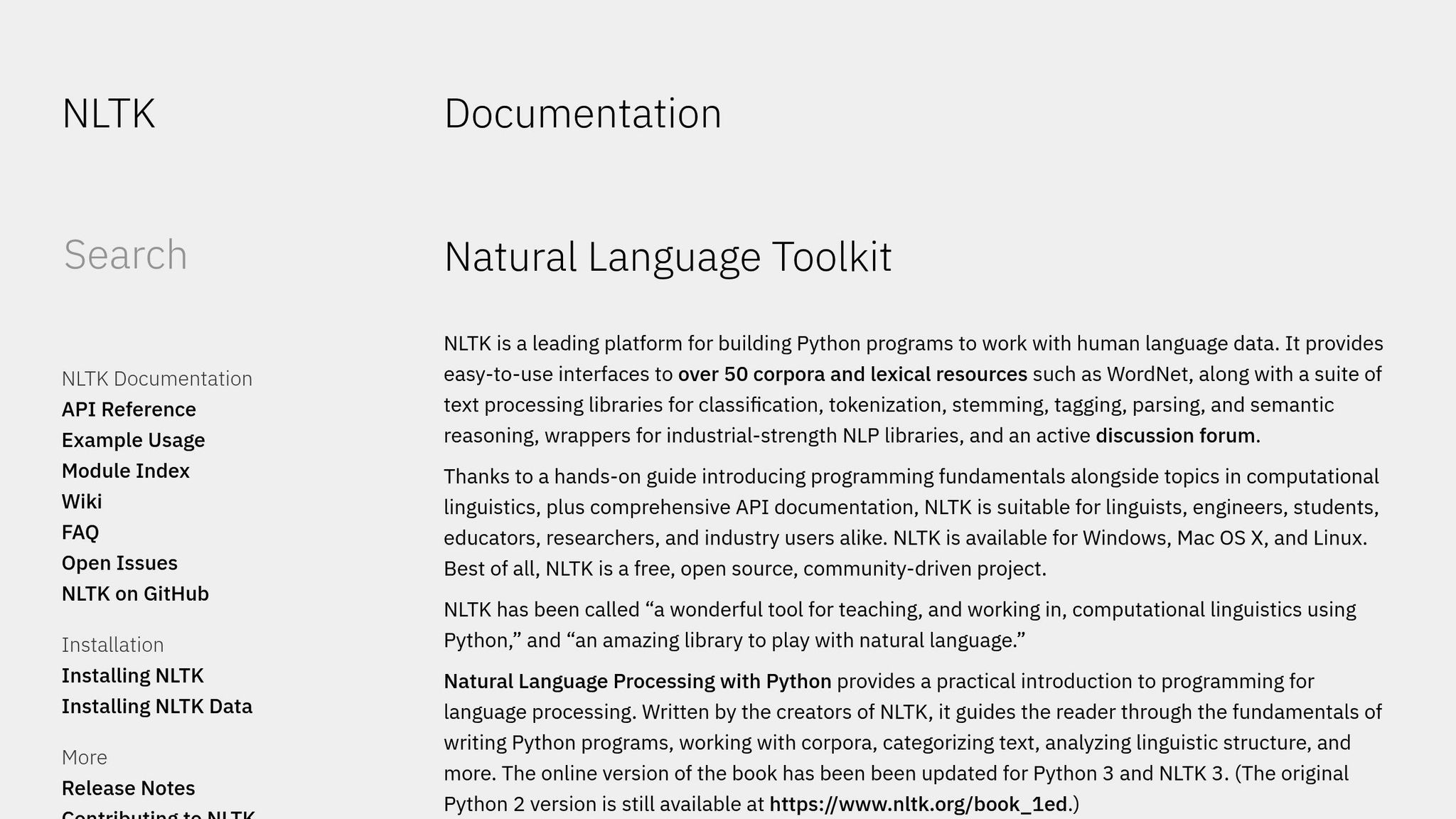
NLTK (Natural Language Toolkit) isn't a dedicated chatbot framework, but its natural language processing (NLP) tools can help you build rule-based conversational systems. This open-source Python library is packed with features that simplify text analysis and processing, making it a handy option for chatbot development.
Core Components
NLTK includes several text-processing tools that are particularly useful for chatbots:
- Tokenization: Breaks text into smaller, meaningful units like words or sentences.
- Part-of-Speech Tagging: Identifies the grammatical roles of words (e.g., noun, verb).
- Named Entity Recognition: Extracts important details such as names, dates, or locations.
- Sentiment Analysis: Evaluates the emotional tone of text, using tools like VADER.
Development Framework
NLTK includes a basic chatbot utility. Here's an example of how to create a simple rule-based chatbot:
import nltk
from nltk.chat.util import Chat, reflections
pairs = [
[r"hi|hello|hey", ["Hello!", "Hi there!", "Hey!"]],
[r"how are you", ["I'm doing well, thank you!", "Great! How can I help?"]]
]
chatbot = Chat(pairs, reflections)
This example uses predefined patterns and responses to handle basic interactions.
Additional Features
Beyond the basics, NLTK offers tools to improve chatbot functionality:
- Statistical methods for language modeling.
- Text classification capabilities for recognizing user intent.
- Regular expression support for advanced pattern matching.
Thanks to its extensive documentation and active community, NLTK is a great resource for developers aiming to add advanced language processing to their chatbots. Its flexibility makes it a solid choice for enhancing chatbot interactions with deeper language analysis.
sbb-itb-7a6b5a0
6. ChatterBot
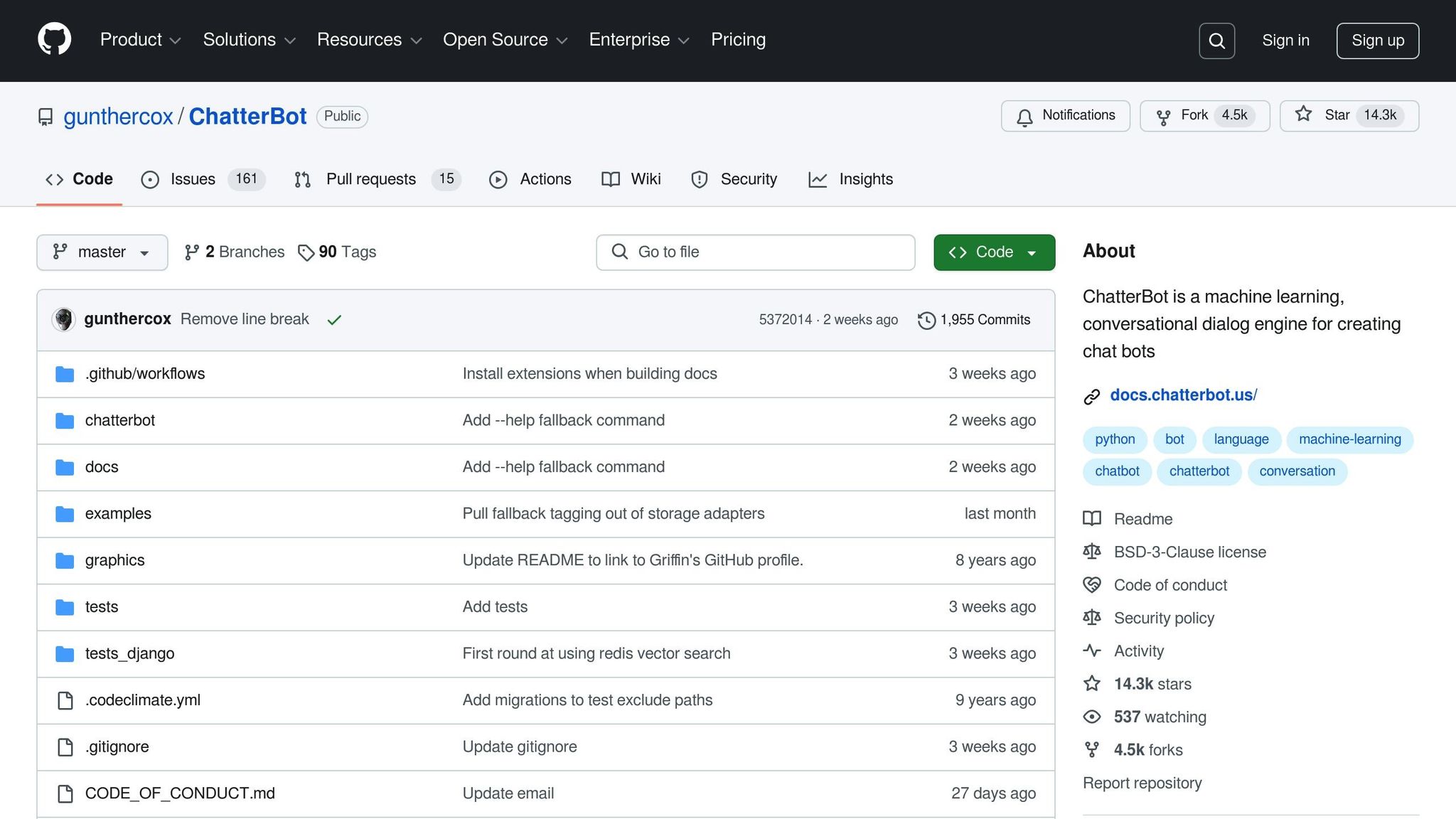
ChatterBot is a Python-powered tool designed for building chatbots with automated responses. It stands out for its simplicity in training and its ability to learn from conversations. You can train it using a pre-built dataset or your own custom dialogue, making it easy to create a chatbot tailored to specific needs.
Getting Started
To begin, install the required packages:
pip install chatterbot
pip install chatterbot-corpus
Here’s a quick example to set up and train your chatbot:
from chatterbot import ChatBot
from chatterbot.trainers import ChatterBotCorpusTrainer
# Create a new chatbot instance
chatbot = ChatBot('MyBot')
# Initialize a trainer with the built-in corpus
trainer = ChatterBotCorpusTrainer(chatbot)
# Train the chatbot using English conversation data
trainer.train('chatterbot.corpus.english')
Training Options
ChatterBot provides two main training approaches:
- Built-in Corpus: Use the pre-loaded conversational datasets for a quick start.
- Custom Training: Add your own dialogue data to create a chatbot that suits your specific domain or use case.
With these options, you can easily develop a chatbot that aligns with your goals, whether for customer service, education, or entertainment.
7. Leon
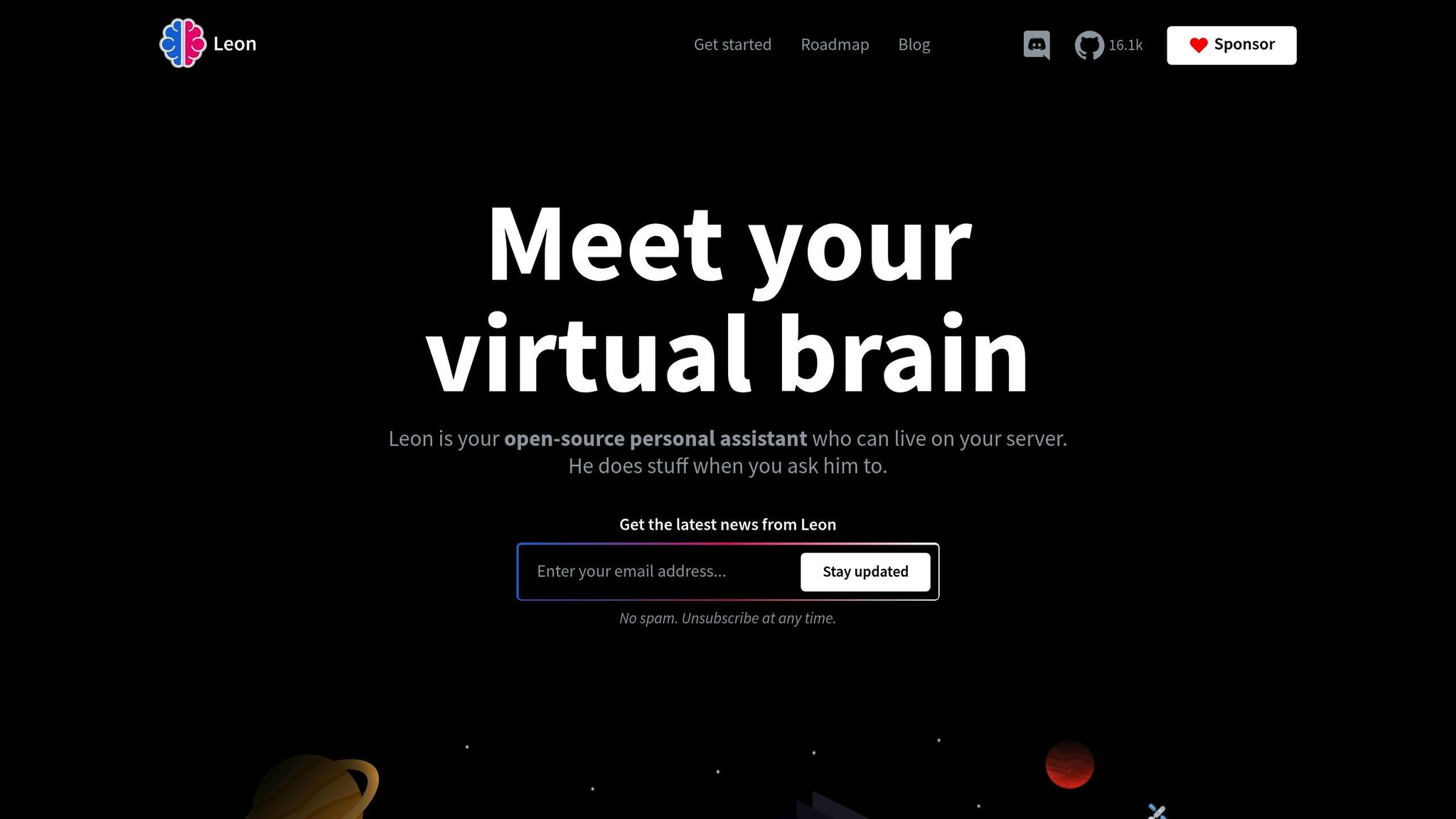
Leon is an open-source personal assistant designed for developers and tech enthusiasts. Built with Node.js and Python, Leon offers a modular structure, making it easy to tailor to different needs.
Key Features
- Offline Operation: Processes data locally to ensure user privacy.
- Cross-Platform Compatibility: Works on Windows, macOS, and Linux.
- Modular System: Expand its functionality by creating or adding custom modules.
Getting Started
Before you begin, ensure you have Node.js (v16 or higher) and Python (v3.8 or higher) installed. Then, follow these steps:
# Clone the repository
git clone https://github.com/leon-ai/leon.git
# Install dependencies
npm install
# Build your instance
npm run build
Creating Custom Modules
To develop your own module, you can use the following Python template:
from leon.base.package import Package
class YourPackage(Package):
def __init__(self):
super().__init__()
self.name = "your_package_name"
def execute(self, query):
# Add your logic here
return self.response
This modular setup allows you to create tailored functionalities while keeping the system efficient.
Performance Tips
Leon is built to be lightweight. To maintain efficiency, activate only the modules you need for your specific use case. This ensures optimal resource utilization, even in limited environments.
8. Hugging Face Transformers
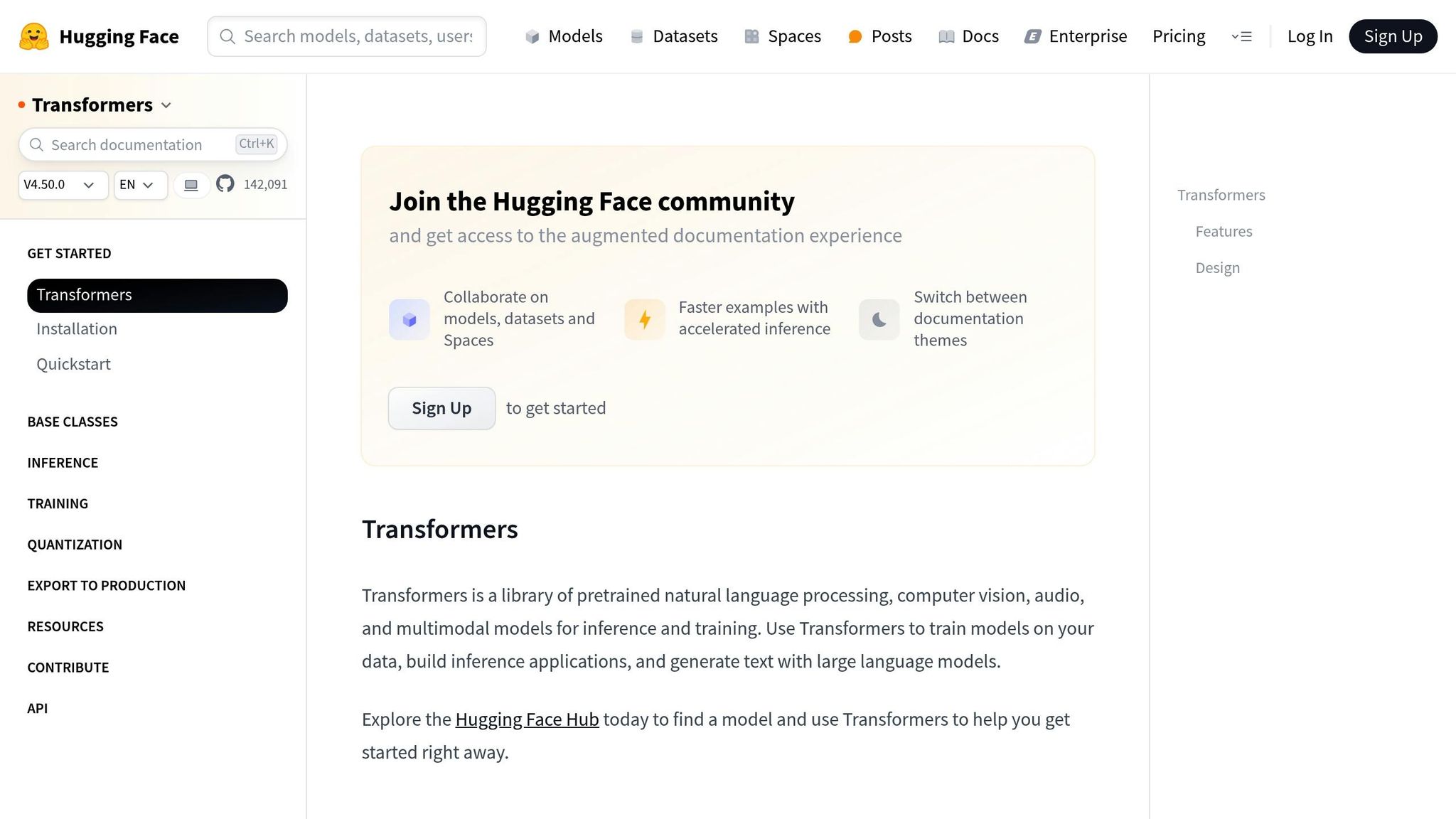
Hugging Face Transformers is a library designed for developing chatbots and other NLP applications, offering thousands of pre-trained models to tackle advanced tasks.
Key Features
This library stands out in several areas:
- Multi-Language Support: Works with over 100 languages right out of the box.
- Task Flexibility: Handles text classification, question answering, and conversational AI tasks.
- Model Options: Includes popular models like BERT, GPT, T5, and other transformer-based architectures.
These features make it a practical choice for building NLP solutions.
Example: Building a Chatbot
Here’s a simple example of creating a conversational agent using Hugging Face Transformers:
from transformers import pipeline
# Initialize conversational pipeline
chatbot = pipeline("conversational", model="microsoft/DialoGPT-medium")
# Generate response
response = chatbot("How can I help you today?")
Tips for Better Performance
To get the most out of your implementation, consider the following:
-
Choose the Right Model
Select a model size that suits your needs. Smaller models are faster for mobile apps, while larger ones are better for complex, enterprise-level tasks. -
Leverage Hardware Acceleration
Use hardware optimization to improve efficiency. For instance:from transformers import AutoModel # Load model with acceleration model = AutoModel.from_pretrained("bert-base-uncased", device_map="auto", torch_dtype=torch.float16 ) -
Batch Processing for Efficiency
Handle multiple inputs in batches to improve throughput:# Process multiple inputs efficiently responses = chatbot(["Hello!", "How are you?"], max_length=50, batch_size=2 )
Practical Integration Tips
- Start with smaller models during early development to save time.
- Add error handling to ensure smooth production deployment.
- Use model quantization to reduce memory usage.
- Cache frequently used responses to speed up interactions.
- Track token usage to balance performance and costs.
Hugging Face Transformers' modular setup makes it easy to integrate into existing systems while maintaining strong performance and reliability.
9. Wit.ai
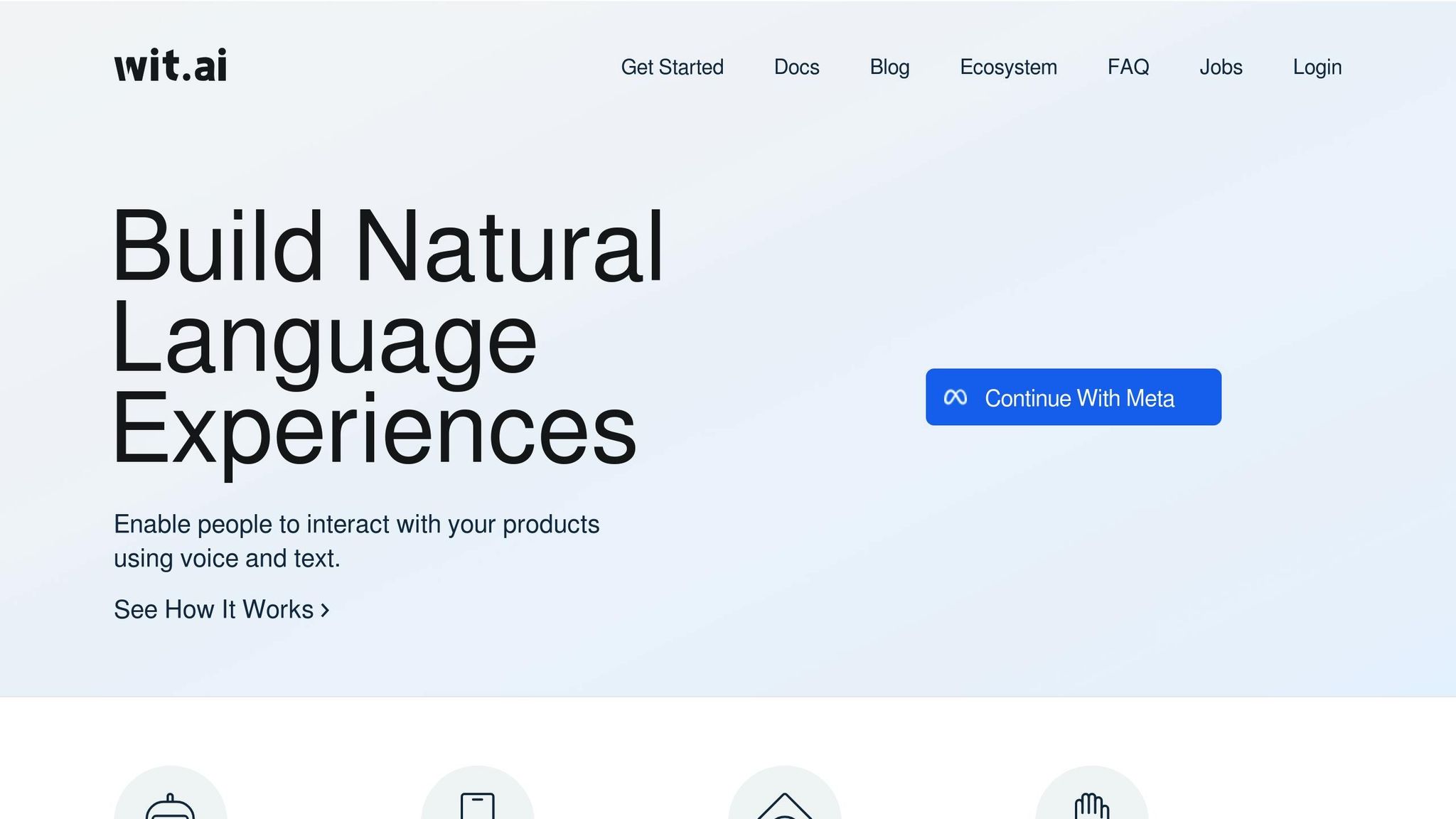
Wit.ai is an open-source platform designed to make creating conversational applications easier. Initially an independent project, it was later acquired by Facebook. Wit.ai uses advanced natural language processing, allowing developers to concentrate on building application features rather than dealing with the challenges of language processing. Up next, we’ll look at another AI chatbot platform.
10. Airy
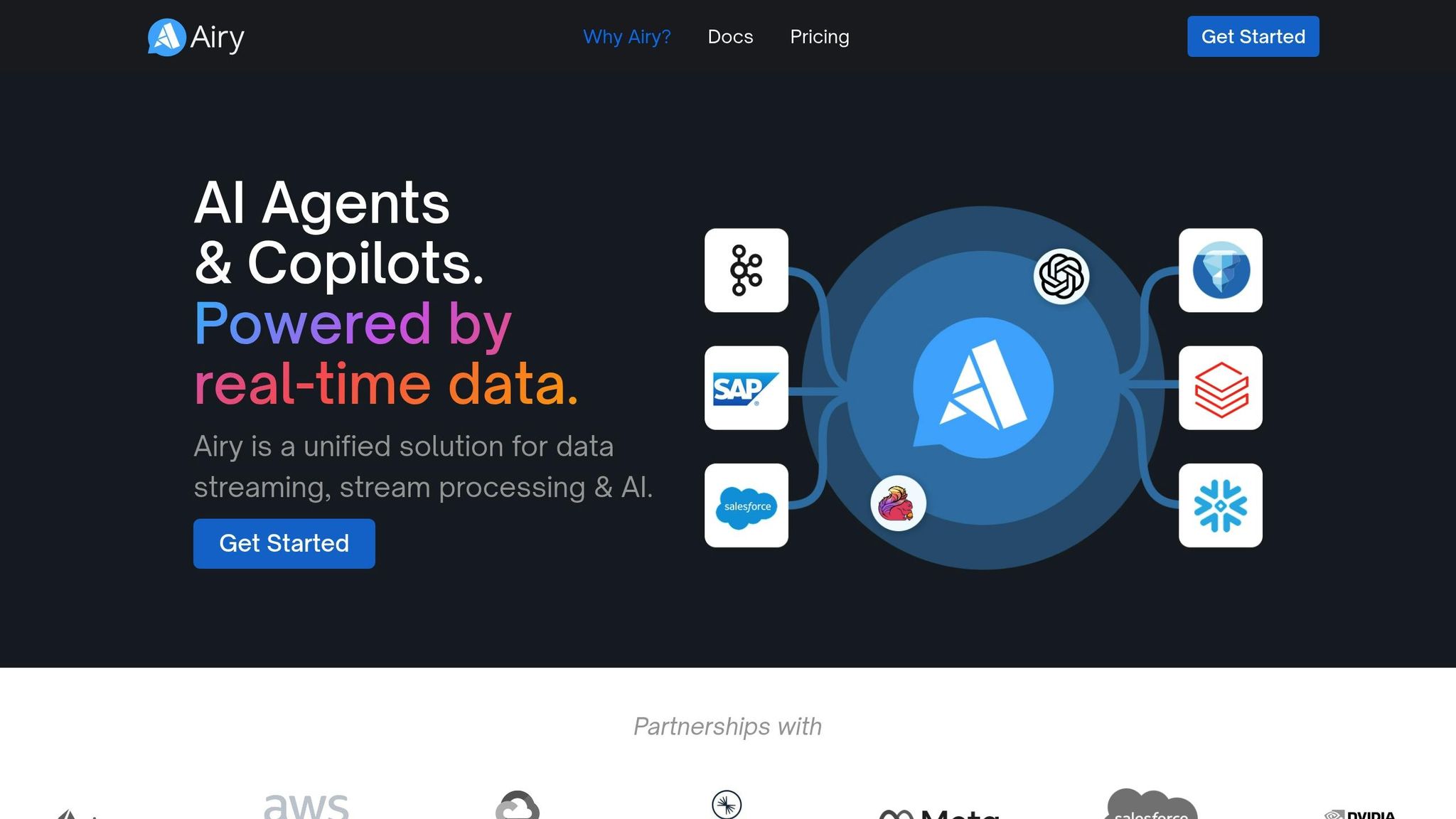
Airy is an open-source chatbot framework designed to handle large-scale customer service automation. Its modular setup allows for customization through various integrations and plugins, making it flexible for different business needs.
Key features include real-time messaging, centralized channel management, and an analytics dashboard for tracking conversation performance and user interactions.
Developers familiar with Node.js and containerization will find Airy straightforward to install. While setting it up does require some technical know-how, the platform provides clear documentation and guides to help users get started.
With its enterprise-focused design, Airy stands out as a strong option among open-source AI chatbot frameworks.
Conclusion
Looking at the top 10 open-source AI chatbots makes it clear: your choice depends on specific needs. Data shows AI chatbots can significantly cut down support tickets and speed up resolution times.
Here are the main factors to guide your decision:
Scalability
Pick a platform that fits your current needs but can also grow with you. Think about:
- How many chatbots you'll need
- Expected message volume
- File handling requirements
- Integration options
Technical Setup
Choose a platform that matches your team's technical expertise. Whether you're looking for no-code simplicity or developer-focused tools, consider:
- Authentication options like SAML/SSO
- API integration capabilities
- Support for custom domains
- Web crawling features
Cost and Value
Evaluate plans based on how you'll use the platform:
| Usage Level | Recommended Plan | Key Features |
|---|---|---|
| Small Scale | Free Plan | 500 messages/month, basic tools |
| Growing Business | Basic Plan ($18/mo) | Unlimited messages, lead collection |
| Enterprise | Custom Enterprise | SAML/SSO, SLA guarantees |
Selecting the right platform is just the beginning. Regular updates and monitoring will ensure your chatbot stays effective and continues to meet your needs.